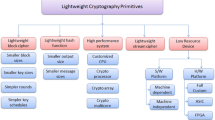Abstract
In Broadcast Encryption schemes, a sender can broadcast the encrypted message securely in a threatening network to a set of legitimate system users only. In IBE scheme any sender can encrypt the desired message using his/her identity without attaining the public key certificate. Here, we have presented an efficient ID-based broadcast encryption scheme (IBBE) for open networks. In this scheme, desired messages can be broadcasted to any subset of the users by any sender but only authorized receivers are capable in retrieving the encrypted messages. This scheme has shorter decryption keys in comparison with other primitive of IBBE scheme for open networks. Moreover, the proposed scheme intends to achieve the lower cost for computation as well as transmission in comparison to earlier existing IBBE schemes.
Similar content being viewed by others
References
Fiat, A., & Naor, M. (1993). Broadcast encryption. In Proceedings of Crypto’93, volume 773 of LNCS (pp 480–491). Springer.
Boneh, D., Gentry, C., & Waters, B. (2005). Collusion resistant Broadcast Encryption with short cipher texts and private keys. In Proceedings of Crypto’05, volume 3621 of LNCS (pp. 258–275).
Delerablée, C., Paillier, P., & Pointcheval, D. (2007). Fully collusion secure dynamic broadcast encryption with constant-size ciphertexts or decryption keys. In Pairing-based cryptography–pairing 2007 (pp. 39–59), Springer.
Boneh, D., Sahai, A., & Waters, B. (2006). Fully collusion resistant traitor tracing with short ciphertexts and private keys. In EUROCRYPT 2006 (vol. 4004, pp. 573–592). Heidelberg: LNCS, Springer.
Shamir, A. (1985). Identity-based cryptosystems and signature schemes. In Advances in cryptology (pp. 47–53).
Boneh, D., & Franklin, M. (2003). Identity-based encryption from the Weil pairing. SIAM Journal on Computing, 32, 586–615.
Gentry, C. (2006). Practical identity-based encryption without random oracles. In Advances in Cryptology-EUROCRYPT 2006 (pp. 445–464). Springer.
Sakai, R., & Furukawa, J. (2007). Identity-based broadcast encryption. IACR Cryptology ePrint Archive, 2007, 217.
Delerablée, C. (2007). Identity-based broadcast encryption with constant size ciphertexts and private keys. In Advances in cryptology—ASIACRYPT 2007 (pp. 200–215). Springer.
Boneh, D., Waters, B., & Zhandry, M. (2014). Low overhead broadcast encryption from multilinear maps. In Advances in cryptology—CRYPTO 2014 (pp. 206–223). Springer.
Li, X., & Yanli, R. (2014). Efficient anonymous identity-based broadcast encryption without random oracles. International Journal of Digital Crime and Forensics (IJDCF), 6, 40–51.
Kim, J., Susilo, W., Au, M. H., & Seberry, J. (2015). Adaptively secure identity-based broadcast encryption with a constant-sized ciphertext. IEEE Transactions on Information Forensics and Security, 10, 679–693.
Wu, Q., Qin, B., Zhang, L., Domingo-Ferrer, J. & Farras, O. (2011). Bridging broadcast encryption and group key agreement. In Advances in cryptology–ASIACRYPT 2011 (pp. 143–160), Springer.
Wu, Q., Mu, Y., Susilo, W., Qinand, B., & Domingo-Ferrer, J. (2009). Asymmetric group key agreement. In Advances in cryptology—EUROCRYPT 2009 (pp. 153–170). Springer.
Boneh, D., Gentry, C., Lynn, B., & Shacham, H. (2003). Aggregate and verifiably encrypted signatures from bilinear maps. In EUROCRYPT 2003 (Vol. 2656, pp. 416–432). Heidelberg: LNCS, Springer.
Li, M. C., Xu, X., Zhuang, R., Guo, C., & Tan, X. (2015). Identity based broadcast encryption schemes for open networks. In 9th international conference on frontier of computer science & technology. https://doi.org/10.1109/fcsc.2015.20.
Author information
Authors and Affiliations
Corresponding author
Additional information
Publisher's Note
Springer Nature remains neutral with regard to jurisdictional claims in published maps and institutional affiliations.
Rights and permissions
About this article
Cite this article
Mishra, P., Renuka & Verma, V. Identity Based Broadcast Encryption Scheme with Shorter Decryption Keys for Open Networks. Wireless Pers Commun 115, 961–969 (2020). https://doi.org/10.1007/s11277-020-07606-6
Published:
Issue Date:
DOI: https://doi.org/10.1007/s11277-020-07606-6




